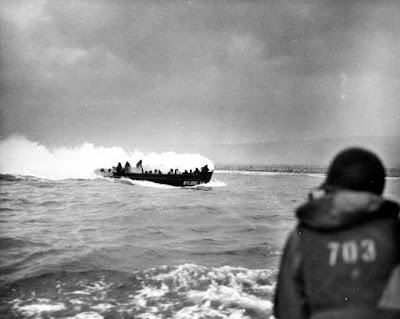More than 150,000 Allied soldiers stormed the beaches of Normandy on June 6, 1944, bursting through German coastal defenses to open the way to the liberation of western Europe from the Nazi regime. The Western Allies of World War II launched the largest amphibious invasion in history when they assaulted Normandy, located on the northern coast of France, on 6 June 1944. The invaders were able to establish a beachhead as part of Operation Overlord after a successful "D-Day," the first day of the invasion. Allied land forces came from the United States, Britain, Canada, and Free French forces. In the weeks following the invasion, Polish forces and contingents from Belgium, Czechoslovakia, Greece and the Netherlands participated in the ground campaign; most also provided air and naval support alongside elements of the Royal Australian Air Force, the Royal New Zealand Air Force, and the Royal Norwegian Navy.
The Normandy invasion began with overnight parachute and glider landings, massive air attacks and naval bombardments. In the early morning, amphibious landings commenced on five beaches codenamed Sword, Juno, Gold, Omaha and Utah, with troops from the United States landing on Omaha and Utah, Britain landing on Gold and Sword and Canada landing on Juno. During the evening the remaining elements of the airborne divisions landed. Land forces used on D-Day sailed from bases along the south coast of England, the most important of these being Portsmouth.
There were several leaks prior to or on D-Day. Through the Cicero affair, the Germans obtained documents containing references to Overlord, but these documents lacked all detail. Double Cross agents, such as the Spaniard Juan Pujol (code-named Garbo), played an important role in convincing the German High Command that Normandy was at best a diversionary attack. U.S. Major General Henry Miller, chief supply officer of the US 9th Air Force, during a party at Claridge's Hotel in London complained to guests of the supply problems he was having but that after the invasion, which he told them would be before 15 June, supply would be easier. After being told, Eisenhower reduced Miller to lieutenant colonel [Associated Press, June 10, 1944] and sent him back to the U.S. where he retired. Another such leak was General Charles de Gaulle's radio message after D-Day. He, unlike all the other leaders, stated that this invasion was the real invasion. This had the potential to ruin the Allied deceptions Fortitude North and Fortitude South. In contrast, Gen. Eisenhower referred to the landings as the initial invasion.
Only ten days each month were suitable for launching the operation: a day near the full moon was needed both for illumination during the hours of darkness and for the spring tide, the former to illuminate navigational landmarks for the crews of aircraft, gliders and landing craft, and the latter to expose defensive obstacles placed by the German forces in the surf on the seaward approaches to the beaches. A full moon occurred on 6 June. Allied Expeditionary Force Supreme Commander Dwight D. Eisenhower had tentatively selected 5 June as the date for the assault. The weather was fine during most of May, but deteriorated in early June. On 4 June, conditions were clearly unsuitable for a landing; wind and high seas would make it impossible to launch landing craft from larger ships at sea, low clouds would prevent aircraft finding their targets. The Allied troop convoys already at sea were forced to take shelter in bays and inlets on the south coast of Britain for the night.
It seemed possible that everything would have to be cancelled and the troops returned to their embarkation camps (which would be almost impossible, as the enormous movement of follow-up formations into them was already proceeding). The next full moon period would be nearly a month away. At a vital meeting on 5 June, Eisenhower's chief meteorologist (Group Captain J.M. Stagg) forecast a brief improvement for 6 June. Commander of all land forces for the invasion General Bernard Montgomery and Eisenhower's Chief of Staff General Walter Bedell Smith wished to proceed with the invasion. Commander of the Allied Air Forces Air Chief Marshal Leigh Mallory was doubtful, but Allied Naval Commander-in-Chief Admiral Bertram Ramsay believed that conditions would be marginally favorable. On the strength of Stagg's forecast, Eisenhower ordered the invasion to proceed. As a result, prevailing overcast skies limited Allied air support, and no serious damage would be done to the beach defences on Omaha and Juno.
The number of military forces at the disposal of Nazi Germany reached its peak during 1944. Tanks on the east front peaked at 5,202 in November 1944, while total aircraft in the Luftwaffe inventory peaked at 5,041 in December 1944. By D-Day 157 German divisions were stationed in the Soviet Union, 6 in Finland, 12 in Norway, 6 in Denmark, 9 in Germany, 21 in the Balkans, 26 in Italy and 59 in France, Belgium and the Netherlands. However, these statistics are somewhat misleading since a significant number of the divisions in the east were depleted; German records indicate that the average personnel complement was at about 50% in the spring of 1944. A more detailed order of battle for D-Day itself can be found at Normandy landings.















0 Comments